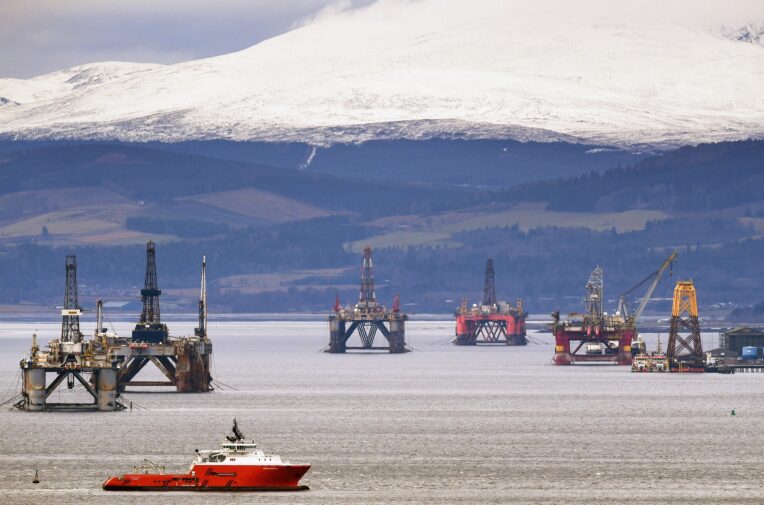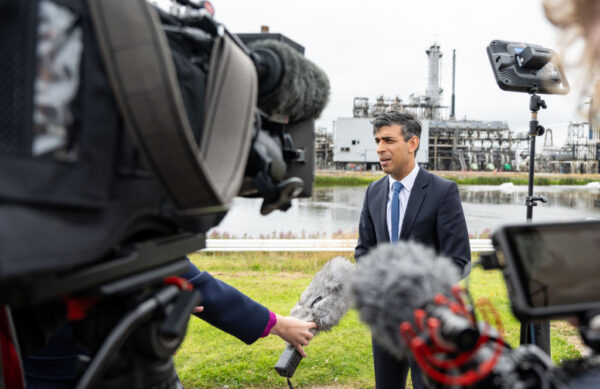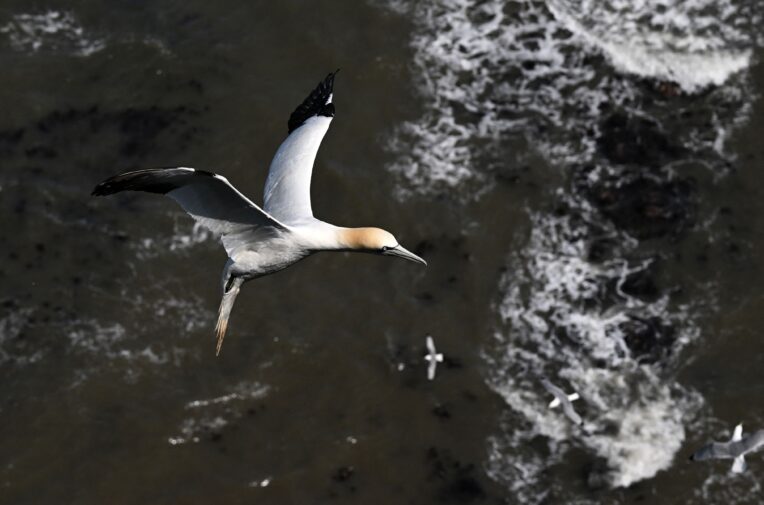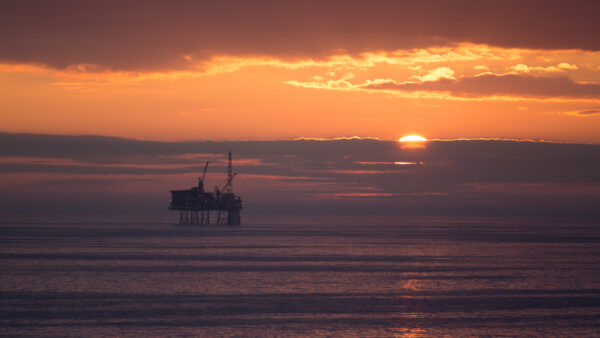
Oil rigs off the Cromarty Firth in the North Sea. In the past decade, hundreds of tonnes of oil has leaked into UK offshore marine protected areas. Photo by Jeff J Mitchell via Getty Images
More than half of oil accidentally spilled in UK waters reached marine protected areas, analysis finds
Investigation into a decade’s worth of spills comes as campaigners voice “grave concerns” about government decision to issue 100 new drilling licences
More than half of oil accidentally spilled in UK waters reached marine protected areas, analysis finds
Investigation into a decade’s worth of spills comes as campaigners voice “grave concerns” about government decision to issue 100 new drilling licences
Oil rigs off the Cromarty Firth in the North Sea. In the past decade, hundreds of tonnes of oil has leaked into UK offshore marine protected areas. Photo by Jeff J Mitchell via Getty Images
More than half of the oil accidentally spilled by offshore oil and gas operations in UK waters over the past decade has ended up in marine protected areas (MPAs) meant to protect rare and threatened habitats and species, an Unearthed investigation has found.
The news comes after prime minister Rishi Sunak this summer promised to authorise more than 100 new oil and gas licences in the North Sea, in a bid to “max out” UK fossil fuel reserves. Number 10 expects the first of these approvals to be dished out this autumn, but around one in every three licences applied for this year sits within or near an MPA, according to a Department of Energy Security and Net Zero (DESNZ) assessment.
The smaller, routine spillages don’t make headlines, but they pollute the UK’s seas every day
– Alyx Elliott, Oceana campaigns director
An Unearthed analysis of official data has found that over the past ten years UK offshore oil and gas operators have reported 551 accidental “oil releases” in fields sitting wholly or partly within protected conservation areas.
In total, these MPA spills released 273 tonnes of oil and oil products – amounting to 54% of the 509 tonnes accidentally spilled in UK waters over the period. The majority of these spills are small and chronic leaks of less than one tonne, often caused by equipment failures, damage, or human error.
But according to the Scottish government’s 2020 Marine Assessment, even small oil spills can have an environmental impact if they happen near species or habitats of conservation importance.
Ocean conservation campaign group Oceana said these chronic oil leaks could accumulate in the environment over time, posing a threat to vulnerable wildlife species.
“The government’s decision to issue 100-plus new licences for North Sea oil and gas raises grave concerns over the damage inflicted on UK seas and ocean wildlife,” said Oceana campaigns director Alyx Elliott. “In these sensitive areas, any risk of large oil spills is deeply worrying, since they could be catastrophic to internationally important marine wildlife and ecosystems.
“But perhaps just as concerning are the smaller, routine spillages from these developments. These don’t make headlines, but they pollute the UK’s seas every day. Whales, dolphins and seabirds, including some of Britain’s most iconic wildlife, are already subject to a constant flow of this chronic oiling.”
Offshore oil and gas operators in UK waters have to report all accidental releases of oil or chemicals to the Offshore Petroleum Regulator for Environment and Decommissioning (OPRED) within six hours, regardless of the volume of the spill. These reports are known as PON1 notices. Unearthed mapped the locations of these reported spills, which are published by the regulator, against MPAs to identify those that happened in fields that sit wholly or partly within protected conservation sites. The analysis excluded accidental spills that occurred before legal protections were established for each MPA. These protections begin at the point when agencies begin public consultation on awarding the site MPA status.
Offshore Energies UK (OEUK), a trade body for the UK’s offshore oil and gas industry, said the reporting of unintentional releases of oil or chemicals was conducted “in an open and transparent manner no matter how small the release”.
“The offshore energy industry recognises that there is no room for complacency when it comes to unintentional releases to sea,” OEUK operations director Mark Wilson told Unearthed. “The industry takes all such releases seriously, regardless of size or potential for harm and are focused on driving continuous improvement.”
He added: “OPRED play a key role in investigating each reported release and the company that reports the release will undertake their own investigation to prevent recurrence.
“For context, the UK annually produces about 40-45 million tonnes of oil and up to 40 billion cubic metres of gas. This equates to just under half the UK’s demand for oil and gas.
“We know that operators and companies across the sector have comprehensive oil spill response plans in place to mitigate against potential incidents occurring and minimise the impact should they occur.”
A DESNZ spokesperson said the department monitored offshore pollution incidents closely, and investigated “all accidental releases reported to us”.
“If required, appropriate action will be taken, including the use of fines or referral for criminal prosecution,” he added.
“As part of the licensing round process, an environmental assessment is undertaken prior to oil and gas operations commencing, which includes an assessment of the risk from oil spills.”
The Foinaven spill
Not all spills reported through the PON1 notices are small. Unearthed’s investigation identified five spills into MPAs over the past decade of two tonnes of oil or more, the definition used by the Advisory Committee for the Protection of the Sea (ACOPS) for a larger-scale release.
By far the worst of these occurred between 2019 and 2020, when a company called Altera Infrastructure spilled approximately 238 tonnes of diesel directly into the Faroe-Shetland Sponge Belt nature conservation marine protected area (NCMPA), in the UK’s worst accidental oil spill since 2017.

Altera was working as a contractor on the Foinaven oilfield, which is operated by oil and gas supermajor BP, when its Petrojarl Foinaven vessel began leaking diesel into the sea.
According to information obtained by Unearthed under freedom of information laws, two stress-induced cracks in one of the vessel’s storage tanks spilled diesel for months before the leak was spotted and stopped.
Diesel oil leaked into the sea from November 06, 2019 to February 04, 2020, according to information provided by DESNZ. OPRED completed a formal investigation of the incident last year, resulting in a £25,000 fine for the subsidiary of Altera that owned the vessel.
A spokesperson for Altera Infrastructure told Unearthed that “the safety of our people and preventing harm to the environment is at the core of our business operations”.
“Unfortunately, we faced a significant diesel spillage three years ago from a vessel that we were operating on behalf of its owner, the Petrojarl Foinaven,” she continued.
“We left no stone unturned in our efforts to learn from the event and maintained our commitment to transparency in all of our operations. This remains the case, where releases and emissions from our operations are tracked in our annual sustainability reports published on our website.”
In 2021, BP decided to suspend oil production from the Petrojarl Foinaven so that the vessel could be retired from use.
BP’s Foinaven oilfield reportedly still contains around 200 million barrels of oil. According to the Guardian, the company has given itself a period of years to decide whether to resume drilling in the field, sell it, or finally decommission it.
The Foinaven field sits wholly within the Faroe-Shetland Sponge Belt NCMPA, meant to safeguard rare giant deep-sea sponges and is home to the only population of the species in UK waters.
A BP spokesperson told Unearthed that the company “takes any unplanned environmental release seriously”.
“Any such release will be reported, and our robust internal processes seek to prevent reoccurrence,” he added. “BP has been operating West of Shetland for many years, working responsibly and in cooperation with relevant regulators and stakeholders. We continue to cooperate and engage in order to contribute to the greater understanding of this complex marine environment.”
After Altera, the company responsible for the second-largest quantity of oil spilled into MPAs over the past decade was the Italian oil supermajor Eni, at 8.9 tonnes.
Eni was also responsible for the second-largest single spill into an MPA after Foinaven. In 2017, an estimated 8.2 tonnes of gas condensate leaked from an export line in the company’s Hewett field, in the southern North Sea.
An Eni spokesperson said that following this leak a “detailed environmental survey and modelling” was carried out “in close cooperation with the environmental regulator” and it was “established that the release was unlikely to have had any significant impact on the marine environment”.
“Every spill that occurred during our operations has been successfully managed,” she told Unearthed.
“Eni UK operates comprehensive maintenance and integrity systems aimed at reducing the potential for any accidental release to the environment. It has effective processes in place to identify any release that does occur, irrespective of size, in full compliance with the UK’s Regulatory reporting requirements.”
She added that Eni was “committed to the protection of the marine environments in which it operates”.
Ecological risks
Smaller-scale chronic oil spills can often go unnoticed for some time, and can occur repeatedly as a result of persistent or continuous leaks. A 2016 scientific study of these accidental releases, published in the journal of Nature Communications, found that “even small spills have immediate adverse biological effects” and their “recurrent nature is likely to affect marine ecosystem functioning.”
“There’s a reason why if someone’s out on a boat and chucked a couple of plastic bottles in the sea, you’d say that’s not okay, because you can see the impact that could have on wildlife,” Oceana’s Elliott told Unearthed. “I see oil in the same way. Even a small amount is going to have a harmful impact. It does not belong there, and the species that live there are highly vulnerable. Many of them are rare and endangered, and the impact is catastrophic.”
“If you have relatively small spills in the wrong area at the wrong time, that can have an impact, particularly if it’s within an Special Protection Area (SPA) which has been designated as a foraging area for seabirds,” said Marine Conservation Society policy officer Richard Hill.
According to the Joint Nature Conservation Committee (JNCC), seabirds are especially vulnerable to oil pollution, and may become contaminated wherever concentrations occur at sea. Researchers have also highlighted that oil spills have potential negative effects on deep-sea sponge aggregations, considered an OSPAR threatened species. Additionally, sharp decreases in heart rate as well as important fluctuations in cardiac activity was observed under all oil concentrations in mussels.
These accidental spills contribute to mounting pressure on the marine environment, which already faces challenges from intensive fishing and warming waters, according to Fiona Gell, a marine biologist and environmental policy specialist.
“A [species targeted for conservation] like an ocean quahog or a sponge aggregation is subjected to so many different pressures, even though they’re in a marine protected area and some of those will be direct if they’ve got oil and gas developments in that area. I think that it is important to bear in mind that it may seem like relatively small amounts [of oil], but it’s one more pressure on those species and habitats and ecosystems that are already under massive pressure,” she told Unearthed.

The UK’s waters are already in a poor environmental state, meeting only three of the 14 key indicators of healthy oceans defined in the government’s marine strategy. Only five offshore Marine Protected Areas are making progress towards their conservation targets.
Hill told Unearthed it was most likely that the more-frequent, smaller-scale spills of oil will be managed through natural dispersion.
“But if you have chronic spills, you’re bound to get some form of environmental contamination over time around rigs. That can change the dynamics of seabed communities,” he said.
Multiple leaks
Certain fields have had more spills reported than others, Unearthed has found. The Leman field, which is divided between Shell and Perenco, saw the highest number of accidental spills within a protected area, with a total of 67 spills reported between 2013 and March 2023.
This field is wholly situated within the Southern North Sea Special Area of Conservation (SAC), which was designated for the protection of harbour porpoises.
Further north is the Schiehallion field, operated by BP, which has seen 60 spills over the period. The field overlaps with the Faroe-Shetland Sponge Belt NCMPA, which is also where the company’s Foinaven field is located. Schiehallion has seen the second highest number of accidental oil spills in or near MPAs in the past decade.
If you have relatively small spills in the wrong area at the wrong time, that can have an impact
– Richard Hill, Marine Conservation Society policy officer
The company responsible for the highest number of accidental spills in the past decade, however, was Shell. Between 2013 and 2023, Shell reported 106 leaks into fields that either overlap or are wholly situated within an MPA, spilling a total of around five tonnes of oil or oil products.
Over the same period, Perenco was responsible for 73 accidental spills in fields sitting wholly or partly within MPAs. These totalled around 3.3 tonnes.
Shell did not respond to Unearthed’s invitation to comment, other than to direct us to OEUK’s statement.
However, a Shell spokesperson told the Times newspaper: “We take our environmental responsibilities seriously and have a range of controls to prevent spillages.”
A Perenco spokesperson told Unearthed that the company had “a strong environment policy in place to ensure that any environmental impact is minimised”.
“Part of this policy is a commitment to report and investigate all environmental related incidents, and to take appropriate measures in order to prevent their recurrence,” he said.
“Perenco operates only gas fields in the UK Southern North Sea, and in fact there is no oil production in the region, only natural gas,” he added. “The majority of reportable releases by Perenco over the past decade have been small quantities of non-production fluids and are not ‘oil spills’ in the commonly understood meaning of the term.”

Plans for new licences
According to the International Union for the Conservation of Nature’s guidelines, oil and gas extraction should not be permitted in MPAs that are intended to maintain, conserve or restore species or habitats.
Despite this, the UK government has promised to approve more than 100 new oil and gas licences in the North Sea, with the first approvals due this autumn. Prime minister Sunak has also indicated he intends to approve the controversial 500m barrel Rosebank field, which according to Equinor’s environmental statement will develop a new pipeline that cuts through the Faroe-Shetland Sponge Belt.
Modelling by campaign groups Uplift and Oceana found that a major oil spill from the Rosebank field could have severe impacts on at least 16 marine protected areas.
“It is crucial that such damage is taken fully into account – alongside the impacts of the climate crisis on the ocean – before any licences are approved for development,” said Elliott.
A recent assessment by DESNZ shows that of the 258 oil and gas blocks or part blocks applied for in this year’s licensing round, 82 of them (32%) are within an MPA or sufficiently near that oil and gas exploration “could potentially lead to significant effects on a site and its features.”
The report concluded that granting licences in these blocks would “not significantly hinder the achievement of the conservation objectives of relevant MCZs or MPAs” but its assessment was limited to the possible effects of initial exploration and surveys, not full-scale oil and gas production. It added that “the potential for significant effects on any relevant site would need to be revisited at the project level, once project plans are known”.
“It takes so much effort to actually consult on protected areas and then work with stakeholders and manage them properly,” said environmental policy expert Fiona Gell. “And if that’s being undermined with what seems to me like really avoidable impacts, then going forward in terms of actually licensing new areas that increase those risks is just not in line with all the commitments that we have set internationally to effectively protect 30% of the ocean by 2030.”
This story was edited at 1:40pm on 12 September 2023, to add a newly received statement from DESNZ.
Unearthed conducted an analysis of a decade’s worth of accidental oil and chemical discharges, specifically Petroleum Operations Notices (PON1), which UK oil and gas installation operators are required to report to the Offshore Petroleum Regulator for Environment and Decommissioning (OPRED) within six hours, regardless of the volume spilled. Each oil and gas field was then mapped in relation to its proximity to marine protected areas using data from the Joint Nature Conservation Committee (JNCC) and the North Sea Transition Authority. Environmental impact assessments from relevant oil and gas companies were sourced to confirm the field’s locations within protected areas.
There are several types of MPAs in the UK. Our analysis included all offshore MPAs:
- Special Areas of Conservation (SACs)
- Special Protection Areas (SPAs)
- Marine Conservation Zones (MCZs) in England, Wales, and Northern Ireland
- Nature Conservation Marine Protected Areas in Scotland (NCMPAs)
- Highly Protected Marine Areas (HPMAs)
Our dataset encompassed all reported PON1 oil spills occurring between January 2013 and March 2023.
We excluded accidental spills that occurred before legal protections were established for each MPA. We used current legislation on offshore protected areas and engaged with the Joint Nature Conservation Committee (JNCC), the public body responsible for nature conservation in the UK’s offshore marine environment, which confirmed that legal protection begins at the point of public consultation, granting “material consideration” status in the marine licensing process. This ensures protection of the marine protected area as if formally designated, obligating measures to prevent habitat and species deterioration. Material considerations remain in effect unless designation of the protected site fails.
In our dataset, we therefore used the dates of earliest public consultation, when the protected area first received material consideration, rather than the date of formal designation.
We shared all relevant PON1 notices that we identified as being wholly or partly within MPAs with the companies named here. In the case of oil and gas fields that only partially overlap MPAs, we removed from our dataset any PON1 notices that the companies identified as being outside of MPAs.

